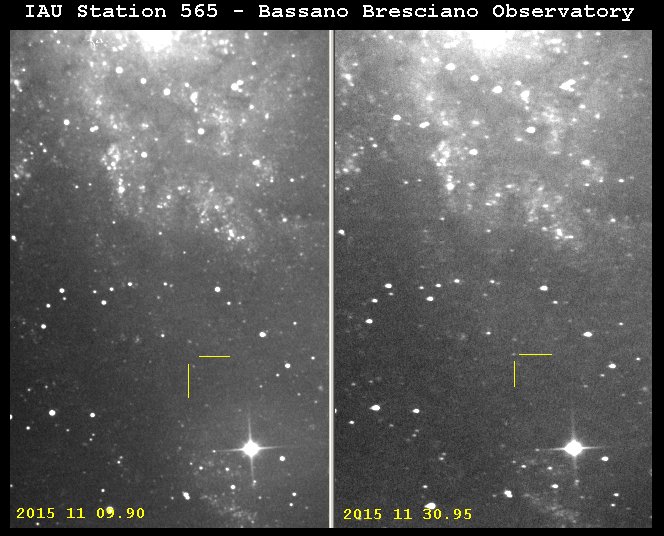We report an indipendent discovery of a new nova in M33 (ASAS-SN15th) made by Bassano Bresciano Observatory on behalf of Italian Supernovae Search Project (ISSP).
See discovery image (and ATEL). Also we reported classification ATEL.

ASAS-SN Discovery of a Probable Nova in M33
ATel #8349; S. Kiyota (Variable Star Observers League in Japan), J. L. Prieto (Diego Portales; MAS), J. S. Brown, T. W.-S. Holoien, K. Z. Stanek, C. S. Kochanek, D. Godoy-Rivera, U. Basu (Ohio State), B. J. Shappee (Hubble Fellow, Carnegie Observatories), D. Bersier (LJMU), Subo Dong, Ping Chen (KIAA-PKU), J. Brimacombe (Coral Towers Observatory), I. Cruz (Cruz Observatory)
on 1 Dec 2015; 14:56 UT
Credential Certification: Jose L. Prieto (
Questo indirizzo e-mail è protetto dallo spam bot. Abilita Javascript per vederlo.
)
Subjects: Optical, Nova, Transient
Referred to by ATel #: 8352, 8396
During the ongoing All Sky Automated Survey for SuperNovae (ASAS-SN or "Assassin"), using data from the quadruple 14-cm "Brutus" telescope in Haleakala, Hawaii, we discovered a new transient source, most likely a nova, in the nearby galaxy M33.
ASASSN-15th was discovered in images obtained on UT 2015-12-01.40 at V~16.5 mag. We do not detect (V>17.1) the object in images taken on UT 2015-11-30.41 and before. An image obtained by S. Kiyota on UT 2015-12-01.51 with a 25-cm telescope at Kamagaya, Japan, confirms the discovery of the transient. This figure shows the archival SDSS g-band archival image (left) and the S. Kiyota V-band confirmation image (right). The red circle has a radius of 15" and is centered on the position of the transient in the S. Kiyota V-band confirmation image.
The position of ASASSN-15th is approximately 765.6" South and 46.8" West from the center of M33 (d=964 kpc, Bonanos et al. 2006, ApJ, 652, 313), giving an absolute V-band magnitude of approximately -8.5 (m-M=24.92, A_V=0.11 mag). This makes it consistent with a possible nova in M33. Properties of the new source and photometry are summarized in the tables below:
Object RA (J2000) DEC (J2000) Disc. UT Date Disc. V mag Approx. Abs. Mag Offset from Host (")
ASASSN-15th 01:33:47.27 +30:26:50.7 2015-12-01.40 16.5 -8.5 767.1
Obs. UT Date V mag 2015-11-30.41 >17.1 2015-12-01.40 16.5
Follow-up observations are encouraged.
We thank LCOGT and its staff for their continued support of ASAS-SN. ASAS-SN is supported by NSF grant AST-1515927, the Mt. Cuba Astronomical Foundation, the Center for Cosmology and AstroParticle Physics (CCAPP) at OSU, and the Robert Martin Ayers Sciences Fund. For more information about the ASAS-SN project, see the ASAS-SN Homepage and the list of all ASAS-SN transients.
Spectroscopic Classification of ASASSN-15th as an Fe II-type Nova in M33
ATel #8352; R. M. Wagner, M. Fausnaugh, K. Stanek (OSU), J. L. Prieto (UDP; MAS)
on 2 Dec 2015; 08:37 UT
Credential Certification: Jose L. Prieto (
Questo indirizzo e-mail è protetto dallo spam bot. Abilita Javascript per vederlo.
)
Subjects: Optical, Nova, Transient
Referred to by ATel #: 8396
We obtained a low-resolution optical spectrum of ASASSN-15th (ATel #8349) on UT December 2.3 with OSMOS mounted on the MDM 2.4m telescope. The spectrum shows Balmer, Fe II (multiplets 42, 48, 49, and 74), and Na I D emission lines exhibiting P Cygni-type line profiles superposed on a blue continuum. After correcting for the redshift of M33 (z=-0.000607, Karachentsev et al. 2013, AJ, 145, 101), we measure a terminal velocity of the H-alpha absorption of -3500 km/s. The FWHM of the H-alpha Gaussian emission component is about 2580 km/s so the average expansion velocity is about 1290 km/s. The spectrum is consistent with an Fe II-type nova in M33 caught early.




